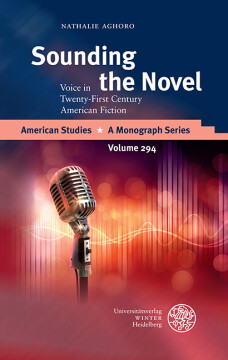
BUCH
Sounding the Novel
Voice in Twenty-First Century American Fiction
American Studies – A Monograph Series, Bd. 294
2018
Zusätzliche Informationen
Bibliografische Daten
Abstract
‘Sounding the Novel’ investigates how American fiction in the early twenty-first century registers the sonic mediality of voice. It looks at ways in which novels enlist the reader’s auditory imagination to establish literary soundscapes where the sound of a voice becomes the main driver for the development of the story and for narrative experimentation. With its focus on novels written after 2000 by Richard Powers, Karen Tei Yamashita, Jonathan Safran Foer, and Jennifer Egan, this study examines the aesthetic and discursive investment in the acoustics of voice as a constitutive part of contemporary literary imaginaries. Drawing on literary theory, sound studies, and philosophy of voice, ‘Sounding the Novel’ discusses how written representations of vocal expression explore the socio-cultural functions of its resonance and its material impact as a corporeal medium in the context of U.S. auditory cultures.
Inhaltsverzeichnis
| Zwischenüberschrift | Seite | Aktion | Preis |
|---|---|---|---|
| Cover | Cover | ||
| Titel | 3 | ||
| Imprint | 4 | ||
| Contents | 7 | ||
| Acknowledgments | 9 | ||
| 1 Introduction: Listening as Literary Practice | 11 | ||
| 2 Sounding Voices | 23 | ||
| 2.1 Voice, Language, and Text | 26 | ||
| 2.2 Toward a Theory of the Sounding Voice: Body, Medium, Performance | 38 | ||
| 2.3 Auditory Imagination, Soundscape, and Voice | 57 | ||
| 3 The Scream and the Word: (Non)Human Voices in Richard Powers’s „The Echo Maker“ | 63 | ||
| 3.1 Human Voice, Primal Echoes, and Language | 68 | ||
| 3.2 Natural Soundscape, Animal Voices, and Ecofiction | 83 | ||
| 3.3 Media Ecology and Voice in „The Echo Maker“ | 96 | ||
| 4 Singing Time: Vocal Performance and Temporality in Richard Powers’s „The Time of Our Singing“ | 103 | ||
| 4.1 The Physics of Voice and Time | 109 | ||
| 4.2 Voice and Possible Worlds in „The Time of Our Singing“ | 117 | ||
| 5 Listening for Voice | 129 | ||
| 5.1 Listening, Resonance, and Voice | 131 | ||
| 5.2 Listening Features | 135 | ||
| 5.3 Intention and Attention | 138 | ||
| 6 Polyphonic Soundscapes: Vocal Resonance and Place in Karen Tei Yamashita’s „I Hotel“ | 145 | ||
| 6.1 The Textualization of Polyphonic Soundscapes | 153 | ||
| 6.2 ‘Live’ Bodies, Vocal Resonance, and Place in „I Hotel“ | 164 | ||
| 6.3 Politics of Voice and Listening | 175 | ||
| 7 A Listening Self: Vocal Sound Event and Intersubjectivity in Jonathan Safran Foer’s „Extremely Loud & Incredibly Close“ | 185 | ||
| 7.1 Auditory Experience and the Listening Self | 190 | ||
| 7.2 War, Terrorism, and Sound Event | 194 | ||
| 7.3 Intersubjective Networks and Urban Soundscapes | 207 | ||
| 8 By Way of Conclusion: Silence in Jennifer Egan’s „A Visit from the Goon Squad“ | 223 | ||
| 8.1 Silences of Anticipation | 228 | ||
| 8.2 Vocal Absence and Intermedial Pause | 233 | ||
| 8.3 From Sound to Silence | 241 | ||
| Works Cited | 245 | ||
| Backcover | 259 |


 Publishing Platform by CloudPublish
Publishing Platform by CloudPublish